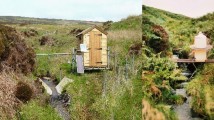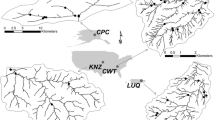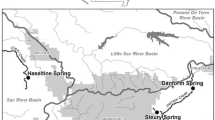Abstract
Many ecosystems rely on subsidies of carbon and nutrients from surrounding environments. In headwater streams that are heavily shaded by riparian forests, allochthonous inputs from terrestrial systems often comprise a major part of the organic matter budget. Bacteria play a key role in organic matter cycling in streams, but there is limited evidence about how much bacterial carbon is actually assimilated by invertebrate and fish consumers, and how bacterial carbon assimilation varies among streams. We conducted stable isotope tracer additions of 13C-acetate, that is assimilated only by bacteria, and 15N-ammonium, that is assimilated by both bacteria and algae, in two small, shaded streams in the Adirondack region of New York State, USA. Our goal was to determine whether there is an important trophic link between bacteria and macroconsumers, and whether the link changes when the light environment is experimentally altered. In 2009, we evaluated bacterial carbon use in both streams with natural canopy cover using 10-day dual-isotope tracer releases. The canopy was then thinned in one stream to increase light availability and primary production and tracer experiments were repeated in 2010. As part of the tracer experiments, we developed a respiration assay to measure the δ 13C content of live bacteria, which provided critical information for determining how much of the carbon assimilated by invertebrate consumers is from bacterial sources. Some invertebrate taxa, including scraper mayflies (Heptagenia spp.) that feed largely on biofilms assimilated over 70% of their carbon from bacterial sources, whereas shredder caddisflies (Pycnopsyche spp.) that feed on decomposing leaves assimilated less than 1% of their carbon from bacteria. Increased light availability led to strong declines in the magnitude of bacterial carbon fluxes to different consumers (varying from −17 to −91% decrease across invertebrate taxa), suggesting that bacterial energy assimilation differs not only among consumer taxa but also within the same consumer taxa in streams with different ecological contexts. Our results demonstrate that fluxes of bacterial carbon to higher trophic levels in streams can be substantial, that is over 70% for some taxa, but that invertebrate taxa vary considerably in their reliance on bacterial carbon, and that local variation in carbon sources controls how much bacterial carbon invertebrates use.





Similar content being viewed by others
References
Allan JD. 2004. Landscapes and riverscapes: the influence of land use on stream ecosystems. Annu Rev Ecol Syst 35:257–84.
Ambrose HE, Wilzbach MA, Cummins KW. 2004. Periphyton response to increased light and salmon carcass introduction in northern California streams. J North Am Benthol Soc 23:701–12.
Arsuffi TL, Suberkropp K. 1989. Selective feeding by shredders on leaf-colonizing stream fungi: comparison of macroinvertebrate taxa. Oecologia 79:30–7.
Azam F, Fenchel T, Field JG, Gray JS, Meyer-Reil LA, Thingstad F. 1983. The ecological role of water-column microbes in the sea. Mar Ecol Prog Ser 10:257–63.
Barbour MT, Gerritsen J, Snyder BD, Stribling JB. Rapid bioassessment protocols for use in streams and wadeable rivers: periphyton, benthic macroinvertebrates and fish, 2nd ed. EPA 841-B-99-002. Washington DC: U.S. Environmental Protection Agency; Office of Water; 1999.
Bartels P, Cucherousset J, Steger K, Eklov P, Tranvik LJ, Hillebrand H. 2012. Reciprocal subsidies between freshwater and terrestrial ecosystems structure consumer resource dynamics. Ecology 93:1173–82.
Baxter CV, Fausch KD, Saunders WC. 2005. Tangled webs: reciprocal flows of invertebrate prey link streams and riparian zones. Freshw Biol 50:201–20.
Cole JJ, Findlay S, Pace ML. 1988. Bacterial production in fresh and saltwater ecosystems: a cross-system overview. Mar Ecol Prog Ser 43:1–10.
Collins SM, Kohler TJ, Thomas SA, Fetzer WW, Flecker AS. 2015. The importance of terrestrial subsidies in stream food webs varies along a stream size gradient. Oikos . doi:10.1111/oik.07213.
Cummins KW. 1974. Structure and function of stream ecosystems. Bioscience 24:631–41.
Das M, Royer TV, Leff LG. 2007. Diversity of fungi, bacteria and actinomycetes on leaves decomposing in a stream. Appl Environ Microbiol 73:756–67.
Davis JM, Rosemond AD, Eggert SL, Cross WF, Wallace JB. 2010. Long-term nutrient enrichment decouples predator and prey production. Proc Natl Acad Sci 107:121–6.
Dodds WK, Evans-White MA, Gerlanc NM, Gray L, Gudder DA, Kemp MJ, Lopez AL, Stagliano D, Strauss EA, Tank JL, Whiles MR, Wollheim WM. 2000. Quantification of the nitrogen cycle in a prairie stream. Ecosystems 3:574–89.
Dodds WK, Collins SM, Hamilton SK, Tank JL, Johnson S, Webster JR, Simon KS, Whiles MR, Rantala HM, McDowell WH, Peterson SD, Riis T, Crenshaw CL, Thomas SA, Kristensen PB, Cheever BM, Flecker AS, Griffiths NA, Crowl T, Rosi-Marshall EJ, El-Sabaawi R, Marti E. 2014. You are not always what we think you eat: selective assimilation across multiple whole-stream isotopic tracer studies. Ecology 95:2757–67.
Ducklow HW, Purdie DA, Williams PJL, Davies JM. 1986. Bacterioplankton: a sink for carbon in a coastal marine plankton community. Science 232:865–7.
Edwards RT, Meyer JL. 1987. Bacteria as a food source for black fly larvae in a blackwater river. J North Am Benthol Soc 6:241–50.
Edwards RT, Meyer JL. 1990. Bacterivory by deposit-feeding mayfly larvae (Stenonema spp.). Freshw Biol 24:453–62.
England LE, Rosemond AD. 2004. Small reductions in forest cover weaken terrestrial-aquatic linkages in headwater systems. Freshw Biol 49:721–34.
Fenchel T. 2008. The microbial loop: 25 years later. J Exp Mar Biol Ecol 366:99–103.
Findlay S. 2010. Stream microbial ecology. J North Am Benthol Soc 29:170–81.
Findlay S, Howe K, Fontvieille D. 1993. Bacterial-algal relationships in streams of the Hubbard Brook Experimental Forest. Ecology 74:2326–36.
Findlay S, Meyer JL, Smith PJ. 1986. Incorporation of microbial biomass by Peltoperla sp. (Plecoptera) and Tipula sp. (Diptera). J North Am Benthol Soc 5:306–10.
Findlay S, Pace ML, Fischer DT. 1998. Response of heterotrophic planktonic bacteria to the zebra mussel invasion of the tidal freshwater Hudson river. Microb Ecol 36:131–40.
Findlay S, Pace ML, Lints D, Cole JJ, Caraco NF, Peierls B. 1991. Weak coupling of bacterial and algal production in a heterotrophic ecosystem: the Hudson River estuary. Limnol Oceanogr 36:268–78.
Findlay S, Tank J, Dye S, Valett HM, Mulholland PJ, McDowell WH, Johnson SL, Hamilton SK, Edmonds J, Dodds WK, Bowden WB. 2002. A cross-system comparison of bacterial and fungal biomass in detritus pools of headwater streams. Microb Ecol 43:55–66.
Giling D, Reich P, Thompson RM. 2009. Loss of riparian vegetation alters the ecosystem role of a freshwater crayfish (Cherax destructor) in an Australian intermittent lowland stream. J North Am Benthol Soc 28:626–37.
Haack SK, Burton T, Ulrich K. 1988. Effects of whole-tree harvest on epilithic bacterial populations in headwater streams. Microb Ecol 16:165–81.
Haack TK, McFeters GA. 1982. Nutritional relationships among microorganisms in an epilithic biofilm community. Microb Ecol 8:115–26.
Hairston NG Jr, Hairston NG Sr. 1993. Cause-effect relationships in energy flow, trophic structure and interspecific interactions. Am Nat 142:379–411.
Hall RO, Meyer JL. 1998. The trophic significance of bacteria in a detritus-based stream food web. Ecology 79:1995–2012.
Hall RO, Wallace JB, Eggert SL. 2000. Organic matter flow in stream food webs with reduced detrital resource base. Ecology 81:3445–63.
Hamilton SK, Tank JL, Raikow DF, Wollheim WM, Peterson BJ, Webster JR. 2001. Nitrogen uptake and transformation in a Midwestern U.S. stream: a stable isotope enrichment study. Biogeochemistry 54:297–340.
Hill WR, Dimick SM. 2002. Effects of riparian leaf dynamics on periphyton photosynthesis and light utilization efficiency. Freshw Biol 47:1245–56.
Hill WR, Ryon MG, Schilling EM. 1995. Light limitation in a stream ecosystem: responses by primary producers and consumers. Ecology 76:1297–309.
Holmes RM, McClelland JW, Sigman DM, Fry B, Peterson BJ. 1998. Measuring N-15-NH4+ in marine, estuarine and fresh waters: an adaptation of the ammonia diffusion method for samples with low ammonium concentrations. Mar Chem 60:235–43.
Hotchkiss ER, Hall RO Jr. 2015. Whole-stream 13C tracer addition reveals distinct fate of newly fixed carbon. Ecology 96:403–16.
Hynes HBN. 1975. The stream and its valley. Int Verein Theor Angew Limnol Verh 19:1–15.
Jespersen AM, Christoffersen K. 1987. Measurements of chlorophyll-a from phytoplankton using ethanol as extraction solvent. Arch Hydrobiol 109:445–54.
Lagrue C, Kominoski JS, Danger M, Baudoin J, Lamothe S, Lambrigot D, Lecerf A. 2011. Experimental shading alters leaf litter breakdown in streams of contrasting riparian canopy cover. Freshw Biol 56:2059–69.
Likens GE, Bormann FH, Johnson NM, Fisher DW, Pierce RS. 1970. Effects of forest cutting and herbicide treatment on nutrient budgets in the Hubbard Brook watershed-ecosystem. Ecol Monogr 40:23–47.
Loeb SL. 1981. An in situ method for measuring the primary productivity and standing crop of the epilithic periphyton community in lentic systems. Limnol Oceanogr 26:394–9.
Meyer JL. 1994. The microbial loop in flowing waters. Microb Ecol 28:195–9.
Mille-Lindblom C, Tranvik LJ. 2003. Antagonism between bacteria and fungi on decomposing aquatic plant litter. Microb Ecol 45:173–82.
Moore JC, Berlow EL, Coleman DC, de Ruiter PC, Dong Q, Hastings A, Johnson NC, McCann KS, Melville K, Morin PJ, Nadelhoffer K, Rosemond AD, Post DM, Sabo JL, Scow KM, Vanni MJ, Wall DH. 2004. Detritus, trophic dynamics and biodiversity. Ecol Lett 7:584–600.
Motomori K, Mitsuhashi H, Nakano S. 2001. Influence of leaf litter quality on the colonization and consumption of stream invertebrate shredders. Ecol Res 16:173–82.
Mulholland PJ, Helton AM, Poole GC, Hall RO Jr, Hamilton SK, Peterson BJ, Tank JL, Ashkenas LR, Cooper LW, Dahm CN, Dodds WK, Findlay SEG, Gregory SV, Grimm NB, Johnson SL, McDowell WH, Meyer JL, Valett HM, Webster JR, Arango CP, Beaulieu JJ, Bernot MJ, Burgin AJ, Crenshaw CL, Johnson LT, Niederlehner BR, O’Brien JM, Potter JD, Sheibley RW, Sobota DJ, Thomas SM. 2008. Stream denitification across biomes and its response to anthropogenic nitrate loading. Nature 452:202–6.
Mulholland PJ, Tank JL, Sanzone DM, Wollheim WM, Peterson BJ, Webster JR, Meyer JL. 2000. Nitrogen cycling in a forest stream determined by a N15 tracer addition. Ecol Monogr 70:471–93.
Nakano S, Murakami M. 2001. Dynamic interdependence between terrestrial and aquatic food webs. Proc Natl Acad Sci 98:166–70.
Newell SY. 1984. Bacterial and fungal productivity in the marine environment: a contrastive overview. Colloq Int Cent Natl Rech Sci 331:133–9.
Nusch EA. 1980. Comparison of different methods for chlorophyll and pheopigment determination. Arch Hydrobiol Bull 14:14–36.
Parkyn SM, Quinn JM, Cox TJ, Broekhuizen N. 2005. Pathways of N and C uptake and transfer in stream food webs: an isotope enrichment experiment. J North Am Benthol Soc 24:955–75.
Pace ML, McManus GB, Findlay SEG. 1990. Planktonic community structure determines the fate of bacterial production in a temperate lake. Limnol Oceanogr 35:795–808.
Peterson BJ et al. 2001. Control of nitrogen export from watersheds by headwater streams. Science 292:86–90.
R Core Team. 2013. R: a language and environment for statistical computing. Vienna: R Foundation for Statistical Computing.
Rong Q, Sridhar KR, Barlocher F. 1995. Food selection in three leaf-shredding stream invertebrates. Hydrobiologia 316:173–81.
Rounick JS, Winterborn MJ. 1983. The formation, structure and utilization of stone surface organic layers in two New Zealand streams. Freshw Biol 13:57–72.
Sabater F, Butturini A, Marti E, Munoz I, Romani A, Wray J, Sabater S. 2000. Effects of riparian vegetation removal on nutrient retention in a Mediterranean stream. J North Am Benthol Soc 19:609–20.
Simon KS, Benfield EF, Macko SA. 2003. Food web structure of epilithic biofilms in cave streams. Ecology 84:2395–406.
Sobczak WV, Burton TM. 1996. Epilithic bacterial and algal colonization in a stream run, riffle and pool: a test of biomass covariation. Hydrobiologia 332:159–66.
Suberkropp K, Chauvet E. 1995. Regulation of leaf breakdown by fungi in streams: influences of water chemistry. Ecology 76:1433–45.
Tank JL, Bernot MJ, Rosi-Marshall EJ. 2007. Nitrogen limitation and uptake. In: Hauer FR, Lamberti GR, Eds. Methods in stream ecology. San Diego: Academic Press.
Tank JL, Rosi-Marshall EJ, Griffiths NA, Entrekin SA, Stephen ML. 2010. A review of allochthonous organic matter dynamics and metabolism in streams. J North Am Benthol Soc 29:118–46.
Thimijan RW, Heins RD. 1983. Photometric, radiometric and quantum light units of measure: a review of procedures for interconversion. Hortic Sci 18:818–22.
Tiegs SD, Peter FD, Robinson CT, Uehlinger U, Gessner MO. 2008. Leaf decomposition and invertebrate colonization responses to manipulated litter quality in streams. J North Am Benthol Soc 27:321–31.
Vannote RL, Minshall GW, Cummins KW, Sedell JR, Cushing CE. 1980. The river continuum concept. Can J Fish Aquat Sci 37:130–7.
Wallace JB, Eggert SL, Meyer JL, Webster JR. 1999. Effects of resource limitation on a detrital-based ecosystem. Ecol Monogr 69:409–42.
Webster JR, Benfield EF. 1986. Vascular plant breakdown in freshwater ecosystems. Annu Rev Ecol Syst 17:567–94.
Webster JR, Benfield EF, Ehrman TP, Schaffer MA, Tank JL, Hutchens JJ, D’Angelo DJ. 1999. What happens to allochthonous material that falls into streams? A synthesis of new and published information from Coweeta. Freshw Biol 41:687–705.
Weyers HS, Suberkropp K. 1996. Fungal and bacterial production during the breakdown of yellow poplar leaves in two streams. J North Am Benthol Soc 15:408–20.
Whiles MR, Hall RO Jr, Dodds WK, Verburg P, Huryn AD, Pringle CM, Lips KR, Kilham SS, Colon-Gaud C, Rugenski AT, Peterson S, Connelly S. 2013. Disease-driven amphibian declines alter ecosystem processes in a tropical stream. Ecosystems 16:146–57.
Wiegner TN, Kaplan LA, Newbold JD, Ostrom PH. 2005. Contribution of dissolved organic C to stream metabolism: a mesocosm study using 13C-enriched tree-tissue leachate. J North Am Benthol Soc 24:48–67.
Wright RT, Hobbie JE. 1966. Use of glucose and acetate by bacteria and algae in aquatic ecosystems. Ecology 47:447–64.
Acknowledgements
This research was supported by funding from the Cornell Biogeochemistry and Environmental Bioxomplexity IGERT program and the Kieckhefer Adirondack Fellowships program. Fumika Takahashi assisted with sample collection in the field and Kim Sparks assisted with preparing equipment for gas sampling. Dan Josephson, Cliff Kraft, the Adirondack League Club, and the Little Moose Field Station provided access to field sites and logistical support. Walter Dodds developed the dynamic compartment model used to calculate turnover time. This manuscript was improved by suggestions from Nelson Hairston Jr., Stuart Findlay, Cliff Kraft, and two anonymous reviewers.
Author information
Authors and Affiliations
Corresponding author
Additional information
Author Contributions
SMC, ASF, JPS, and SAT designed and planned research. SMC and SAW conducted field research and SMC coordinated lab and statistical analyses. JPS led methods development of respiration assays, SAT led method development of isotope tracer design. SMC wrote the manuscript with contributions from all authors.
Electronic supplementary material
Below is the link to the electronic supplementary material.
Rights and permissions
About this article
Cite this article
Collins, S.M., Sparks, J.P., Thomas, S.A. et al. Increased Light Availability Reduces the Importance of Bacterial Carbon in Headwater Stream Food Webs. Ecosystems 19, 396–410 (2016). https://doi.org/10.1007/s10021-015-9940-3
Received:
Accepted:
Published:
Issue Date:
DOI: https://doi.org/10.1007/s10021-015-9940-3




